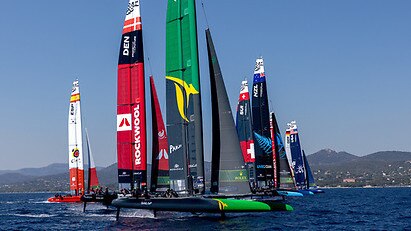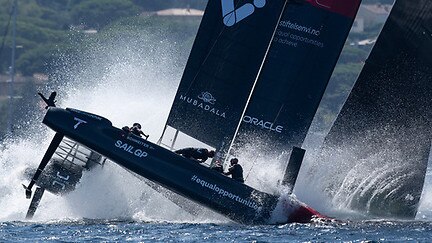SailGP Cadiz: Australian wing trimmer Kyle Langford embracing technical side of sailing
For someone who hated school it sounds like the job from hell. Work all day then bunker down for hours of homework. But it is this Australian SailGP gun’s dream job.
Local Sport
Don't miss out on the headlines from Local Sport. Followed categories will be added to My News.
For someone who hated school it sounds like a nightmare. Work all day then head home for hours of homework. But it’s Australian sailing guru Kyle Langford’s dream job.
When Langford was at high school in Newcastle, north of Sydney, he dreamt of being set free from the classroom to go sailing.
Now, one of Australia’s most respected and credentialed sailors is back in it constantly and ironically loving every second working on a hi-tech numbers game.
The performance of Langford and his Australian teammates in the SailGP series is as critical off the water as it is on it in a world where sensors pick up and compile crucial data later poured over by teams hunting a winning edge.
So at the end of each day of racing on the circuit - this weekend in Spain - for round five of SailGP season four - Langford heads somewhere quiet to do his homework.

It’s a big turnaround for the Australian who attended St Phillips College in Newcastle as a boat-mad teenager and who has been part of every Australian crew to win the SailGP since the series inception four seasons ago.
“I finished school and went sailing,” said Langford, who at 34 has done and won America’s Cups, raced in the Volvo round the world and on multiple Sydney to Hobart supermaxis.
“I never took up my spot at uni. I hated school but I like this sort of home work.
”I love the technology. It brings a new level of understanding. Once you dig into the data you understand and appreciate what makes a boat go fast which is crucial.’’

Langford is the wing trimmer on the Flying Roo, with his job involving both sailing, split second decision making and on-the-move data analysis as he is responsible for the speed of the F50 - a foiling craft capable of speeds in excess of 52 knots - via controls, a joy stick and buttons.
The wing he controls is 24m and is altered for specific wind conditions to increase the F50’s speed and reduce drag.
The foiling catamarans raced in SailGP have 400 sensors on board collecting more than 300,000 data points every second.
Data is recorded on such things as angles, foils, loads and pressures to create a comprehensive volume of data which can be read and assessed by crews post race.
“We have 20 hydraulic cylinders and their pressure is recorded, along with the boat speed, how long we are flying over the water,’’ Langford said. “The smart guys can calculate tides and current as well.
“All these things are measured and then compiled into a report which we get at the end of the day.
“There are things in it like how long it takes the boat to get out of the water, what is influencing that, a lot of different factors.
“Our team has the experience to realise which variables have an impact on. Some of this analysis is really important.’’

Every sailor in the team has their own display to use while racing.
“The display is hard wired to the boat and that's because we don't want any lag in the numbers. With wireless it could be slower,’’ Langford said.
“Everything on board is recorded 100 times a second.
“Sailing is a spot that relies heavily on feeling. We use this data to validate our feeling. So you have to be a good sailor. You are not just a computer operator.’’
UPCOMING SAILGP EVENTS
October 14-15: Spain Sail Grand Prix – Andalucía-Cádiz
January 13-14: UAE Sail Grand Prix – venue to be announced
February 24-25: Australia Sail Grand Prix – Sydney
March 23-24: New Zealand Sail Grand Prix – Auckland
May 4-5: Bermuda Sail Grand Prix
More from AMANDA LULHAM HERE





